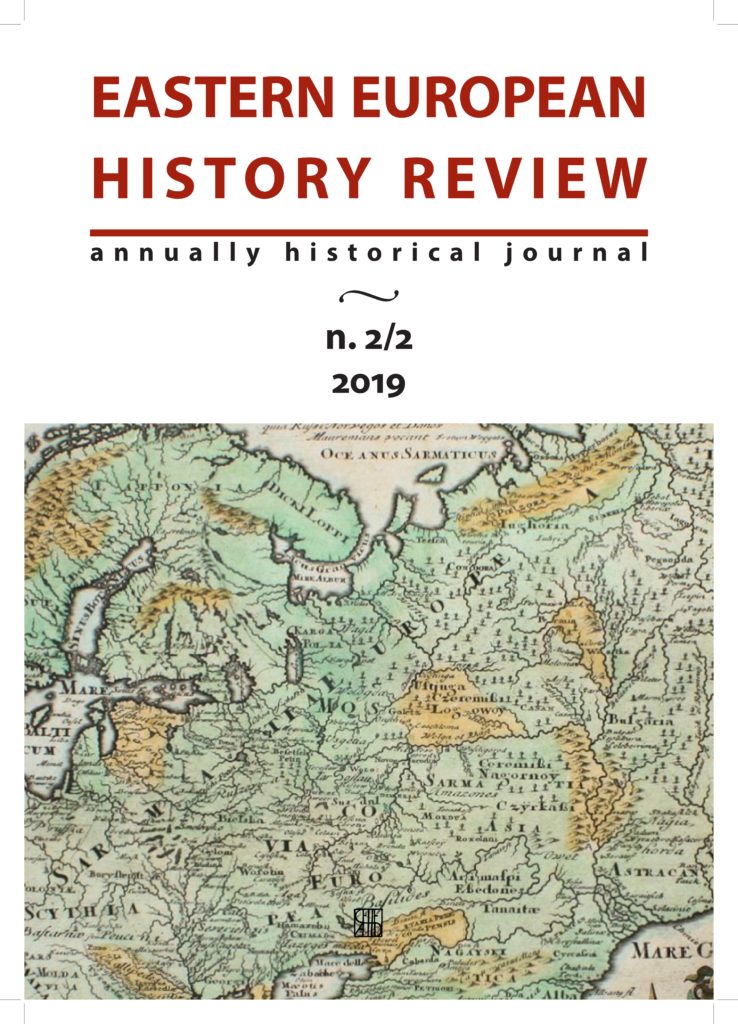
EASTERN EUROPEAN HISTORY REVIEW, n. 2-2 (2019)
p. 5 Introduzione/Introduction
p. 9 Gaetano Platania
Istituto Nazionale di Studi Romani
Title: THE TURKISH THREAT AND THE IDEA OF “CRUSADING” IN THE PAPAL POLICY OF THE MODERN AGE IN THE STUDY OF SOME UNPUBLISHED OR RARE WORKS OF LAY OR RELIGIOUS AUTHORS (XV-XVIIc.).
Abstract: After the defeat of Constantinople (1453), the Holy See feared that the Turkish threat could also affect Europe and therefore Christianity. for this reason, during the early modern age, many popes felt the need to fight against the Muslim enemy: within a long list, we must include the names of Eugene IV [1431-1447], Pius II [1458-1464], Alexander VII [1655-1667], and Innocent XI [1676-1689] over of all. When the Turks, after the defeat of Lepanto (1561), showed to aim for the heart of Europe, passing through the Danubian-Balkan area, Pope Odescalchi was the proponent of a new, and modern, crusade.
The essay, after reflecting on the term “crusade”, retraces all the diplomatic phases that saw Pope Innocent XI as an occult director in an attempt to defeat the infedele enemy before, and during, the dramatic siege of Vienna (1683)
Keywords: Crusade, Papal policy, Modern, Innocent XI, Ottoman empire.
p. 27 Sylwia Konarska-Zimnicka
Institute of History, Jan Kochanowski University in Kielce
Title: EVALUATION OF TIME: ELECTIONAL ASTROLOGY ACCORDING TO CRACOW ASTROLOGICAL PREDICTIVE TEXTS OF THE PRE-COPERNICAN TIMES.
Abstract: Man has always looked for guidance – confirmation of the choices he made. Very useful proved to be astrology, which secrets were used in the prediction of future events. Based on the announcement flowing “from heaven” tried to “outwit fate” and in the case of a preferred arrangement of the heavenly bodies deliberately undertaken various activities, while avoiding taking any decision in the case of unfavorable configuration of celestial bodies. In this context, the time turned out to be an ally or an enemy. And it was the role of astrological forecasters to identify the moments conducive or not making all kinds of decisions or actions which, although sometimes trivial, sometimes, however, experienced a fateful …
Keywords: medieval astrology, university in Cracow, calendars, almanacs, time.
p. 37 Michał Hirsch
Adam Mickiewicz University in Poznań
Title: GIACOMO DELLA PORTA ARCHITECT OF THE POLISH NATIONAL CHURCH OF ST. STANISALO IN ROME.
Abstract: The beginnings of the Polish church of St. Stanislaus dates back to 1578, when on the initiative of Cardinal Hozjusz a Polish national institution was established in Rome. At that time, Pope Gregory XIII granted Poles the medieval church of San Salvatore in Pensilis. Two years later, construction works began on the site of the old church, which ended in 1591 during the solemn consecration of the temple. In the sources, the name of the author of the design of the Polish church has not been preserved, but the style of architecture, spatial concept, as well as architectural detail seem to confirm that it was the most influential architect of the second half. 16th century in Rome, Giacomo della Porta. His authorship is also due to the fact that during the construction campaign, the cardinal protector of Poland was Alessandro Farnese, a great patron of the arts and patron of artists, whose court architect was Giacomo della Porta.
Keywords: Modern history, 16th century, Rome, Giacomo della Porta, Alessandro Farnese.
p. 67 Francesca De Caprio
Università della Tuscia
Title: L’ENTRATA SOLENNE A DANZICA DELLA REGINA DI POLONIA LUDOVICA MARIA GONZAGA NEVERS ATTRAVERSO ALCUNI RESOCONTI FRANCESI ED ITALIANI.
Abstract: The solemn entrance of the Queen of Poland Maria Ludovica Gonzaga Nevers in Gdansk through some French and Italian reports. After a long and complicated diplomatic negotiation, on 5 November 1645 the Princess Ludovica Maria Gonzaga Nevers married by proxy in Paris the King of Poland Władysław IV Wasa. On 27 October 1645 the Queen, who had changed her name to Louise Marie (and then in Ludwica Maria), left for Poland. After more than two months of a triumphant journey, she finally arrived on 8 February in Royal Prussia. The Queen had entered finally into territories governed by her husband. This change in status of traveller, who is now no longer a Royal guest but is the Queen Consort in the reign of her husband, is immediately reported in the reports of the voyage. The triumphal welcome in Gdansk had been scheduled for a double solemnity: that of the first entry of the sovereign and that of the religious ceremony, as we know the religious ceremony took place in Warsaw; but till the last moment the King had tried to comply with the program to celebrate it in Gdansk. And welcome in the city continued to refer both the entrance and the wedding ceremony. We understand, therefore, why the hospitality in Gdansk were so solemn and magnificent.
Keywords: Royal Wedding, Ceremony, Baroque, Marriage Culture, Travel.
p. 85 Giulio Merlani
University of Caen Normandy
Title: FRANCESCO BUONVISI E LA PREPARAZIONE DEL CONGRESSI DI NIMEGA: LA SANTA SEDE TRA MEDIAZIONE ED ESCLUSIONE DALLE TRATTATIVE DI PACE.
Abstract: On 20 July 1675, Francesco Buonvisi received the post of ordinary nuncio to the court of Vienna. This task had been entrusted to Lucca thanks to his brilliant and effective nunciature carried out in Warsaw in the two years 1673-75. The aim of this new task was to induce Leopold of Habsburg to achieve continental peace with Louis XIV and then concentrate all his efforts on the fight against the Ottoman empire that was threatening Hungary. In this political-diplomatic framework, Pope Clement X tried strenuously to mediate between the two major European powers to reach an agreement.
The article analyzes, through the examination of the diplomatic correspondences sent and received by Buonvisi in Vienna, the complex political framework that would have led to the peace of Nijmegen in 1678.
Keywords: Buonvisi, Habsburg, Luois XIV, Holy See, Papal Policy.
p. 103 In memory of Józef Andrzej Gierowski (1922-2006)
Title: CHOCIM 1673(Article in Polish Language)